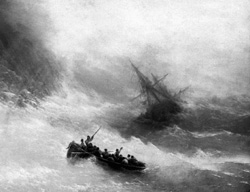Ivan Aivazovsky and his Circle exposition at Kyiv’s Museum of Russian Art

Aivazovsky is an artist everybody knows and nobody wants to argue about.
To begin with, his first name is actually Ovanes, not Ivan, and that for 24 years his last name was Gaivazovsky. He came from an old Armenian aristocratic family, first settling in Halychyna in the seventeenth century, and then moving to Feodosiya, being considerably impoverished. Thus the future academician (he received the laurels very early) first worked as an errand boy in a coffeehouse. He had both opportunities in addition to the artistic talent. For example, an eventual dissident: his picture, winning a second class silver medal, appeared on display “without the management’s permission” and the news reached Nicholas II. Fable writer Krylov interceded and the picture was bought for the Winter Palace. Aivazovsky, the archaeologist, in 1853 dug up over eighty burial mounds, finding among other things, pieces of jewelry dating from the fourth century BC. Aivazovsky was the companion of geniuses. He played preference with Gogol, music with Glinka. Aivazovsky, the busy bee and a part-time crackpot produced 6,000 works done during his lifetime (other sources point to 4,000); sometimes he would paint several pictures a day, starting at six in the morning and finishing at four in the afternoon, jumping in place. Many have written about Aivazovsky as a man of charity and friend of the Ukrainian people.
Who was he, a singer of the sea? Aivazovsky has pictures of a somewhat different nature: a series a canvases dedicated to Columbus, Napoleon on Saint Helena, The Death of Pompeii, The Moscow Fire of 1812, Ancient Gothic Arbor (his first painting, 1829), and Chaos purchased by Pope Gregory XVI for his collection. Even his Ninth Wave ranked with Gericault’s Raft of the Medusa. While the latter was based on an actual political scandal (an early nineteenth century version of the Admiral Nakhimov), the former was worked upon hard by Soviet critics who saw in it a social allegory: tired heroes mustering what strength they still had to ward off the tidal wave of tsarist autocracy. Some prefer things “more social,” but for a romantic this will suffice.
Specifically, you are frozen for a long time in front of A Scene from Cairo Life (1881): merchants relaxing and enjoying it, smoking their hookahs, casting bored glances at an odalisque dressed in rags. And the gilded cupola of the mosque if of fairy tale beauty, shimmering like a sea wave.
Aivazovsky’s storms were painted simultaneously with Isidor Dukas, le Comte de Lautreamont’s Les chants de Maldoror.
As for Aivazovsky’s followers, they have been legion. One is moved by Bogoliubov’s meticulous “natural” details; Blinov’s topographic precision of the ship’s appurtenances, Sudovsky’s liquid transparency effects... The impression is that his marine students got together and distributed among themselves the “spheres of (maritime) influence.” Yet this did them no good, least of all in our century.
Aivazovsky begot mass culture and this mass culture has spent a century trying to surpass Aivazovsky, but it cannot.
Випуск газети №: Рубрика






